
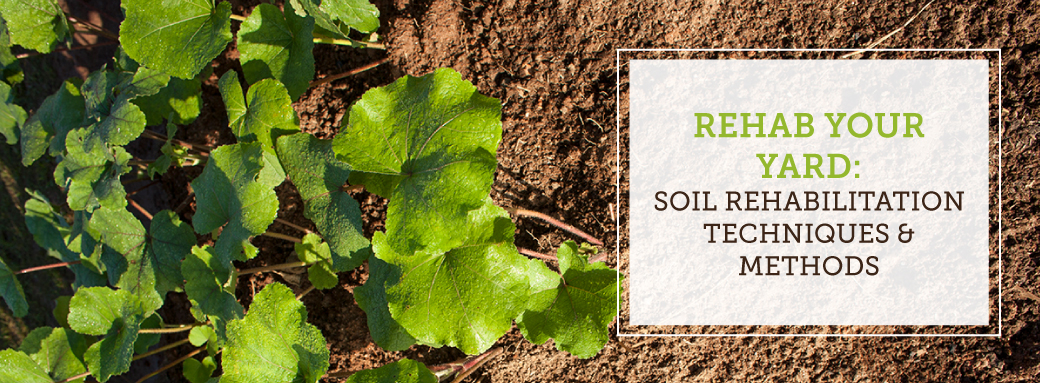
Rehab Your Yard: Soil Rehabilitation Techniques and Methods
Healthy and thriving trees are some of the largest and most important components in creating a beautiful landscape. Trees establish the framework for a property’s design. They significantly contribute to the visual impact and intended statement. Keeping trees vibrant improves visual appeal and protects overall value.
Large, established trees may appear indestructible, but they’re not. It takes years to grow a tree where the trunk, branch and canopy size are mature and settled. Older trees seem maintenance-free, as they’ve developed incredible root systems that continuously source carbon, oxygen and water.
But without a constant supply of life-giving nutrients, trees quickly go into distress and can die.
How Does Soil Impact Trees?
In addition to essential nutrients, trees are vitally dependent on the soil they’re anchored in. Most people take soil for granted when gazing at trees. While standing on the ground and looking up to the limbs and leaves to appreciate a tree’s majestic beauty or examine it for signs of stress, disease or insect infestations, most fail to appreciate that the biggest factor in delivering life to the tree is directly below their feet.
Perhaps you’ve found yourself wondering: How exactly how does soil impact tree growth? Tree growth is just as dependent on the right combination of soil composition and drainage for strong health as it is on the proper light conditions from above.
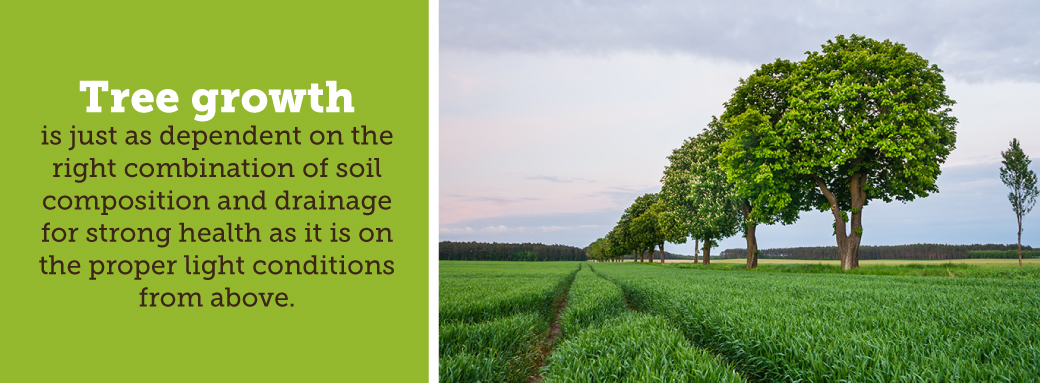
Over time, soil can become depleted of nutrients or any of the other complex components that make up healthy soil. Damaged soil is a leading cause of tree troubles. Fortunately, soil rehabilitation is a solution for ensuring continued tree growth.
But what is soil rehabilitation — and how does it work? Soil rehabilitation is actually straightforward when equipped with a proper understanding of what soil is and some knowledge of how to rehabilitate old or damaged soil for optimum tree health.
Soil Composition
Soil is primarily composed of minerals, organics, oxygen and water. All four components need to work in unison for supplying life to a tree. They also have to combine and compact to provide a stable base that supports the massive weight of a tree, allowing it the flexibility to bend and twist during heavy storms.
When soil is old, degraded or damaged, the tree’s life support system is compromised. Old soil may be deprived of organics or it may be severely compacted and not allow root spread or oxygen flow. Damaged soil might be polluted by heavy metals or toxins, such as pesticides or herbicides. Degraded soil is usually low on organics, which serve as the tree’s fertilizer supply.
Water, oxygen, organics and minerals are the nutrients trees require to live. Water can be supplied naturally by rain or ground sources, but requires well-draining soil to flow to the roots. Oxygen reaches a tree from its leaves or needles as well as through the roots. Proper soil composition allows the correct air volume for roots to breathe.
Organic material is supplied by decaying plants and microbial action that break down organic compounds and provide food. Minerals are present in the rocks, sand, clay and inert material present in the non-living world.
The Need for Nutrients
Trees require all these nutrients to live and thrive. When soil is nutrient-deficient, trees can’t reach their full potential. They will be less impressive as landscape features, more susceptible to insect or disease issues and will live a shorter life overall than trees growing in proper soil conditions.
Plant nutrients are divided into two groups based on the quantity necessary for growth:
- Macronutrients are required in large amounts. They include nitrogen (N), phosphorus (P), potassium (K), calcium (Ca), magnesium (Mg) and sulfur (S). Deficiency in any of these macronutrients, especially nitrogen, results in slow growth and significant stress symptoms.
- Micronutrients are required in small or trace amounts. They include iron (Fe), manganese (Mn), zinc (Zn), copper (Cu), boron (B), chlorine (Cl) and molybdenum (Mo). Trees are less susceptible to micronutrient deficiency, with the exception of iron.
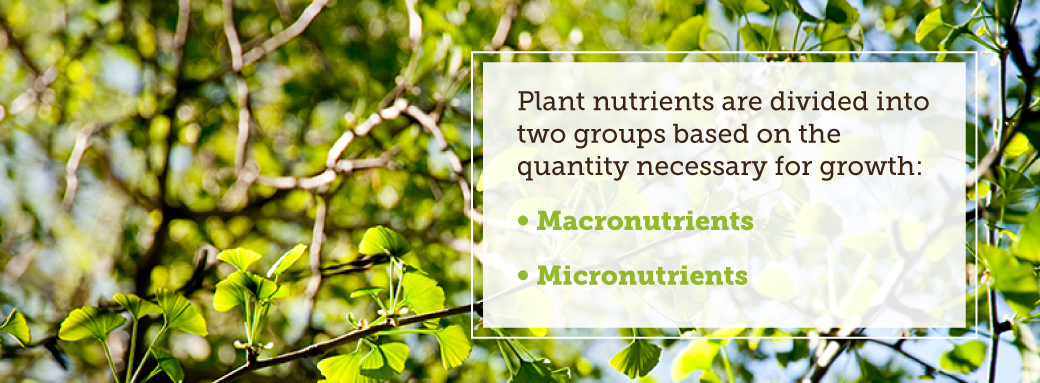
Macro- and micronutrients are part of the soil’s overall fertilizer reserve that feeds the trees in your yard. Some fertilizer nutrients occur naturally in soil and some are added by humans who tend for their trees. Truly organic fertilizers are a mixture of mineral particles like sand, clay and silt. Combined with dead leaves and rotting wood, they’re a hive of microscopic, biological life.
“Real soil” — as organic-based soil is sometimes termed — is part of life’s natural cycle. It requires cooperation with animal, mineral and vegetable compounds that occur in the natural cycle of life that contribute to other life forms being healthy.
Natural Organic Fertilizers
Organic fertilizers occur naturally from decomposing plants, while inorganic fertilizers are synthetic or man-made. Inorganic fertilizers are normally highly soluble in water and break down quickly to supply plant nutrients. Organic products take time to dissolve and release nutrients slowly. These are called “slow-release” fertilizers. Often, commercial fertilizers are combined so that some nutrients are available to a plant immediately and some require an extended time period. These fast- and slow-releasing fertilizers are designed for specific applications.
Tree soil fertilizers are available in a wide range of nutrient balances. The primary nutrients are nitrogen (N), phosphorous (P) and potassium (K). These complete fertilizers are rated in an N-P-K ratio and are labeled with numbers corresponding to their weight amount in a 100-pound fertilizer mix.
For example, 100 pounds of a common fertilizer marked 6-8-6 would contain six pounds of a nitrogen base, eight pounds of phosphorus and six pounds of potassium. There is no correct or one-size-fits-all fertilizer ratio for trees. The right fertilizer depends on the species of tree, its stage of development, the time of year and a host of other factors. It’s wise to consult a professional for help with selecting the right type of soil fertilizer.
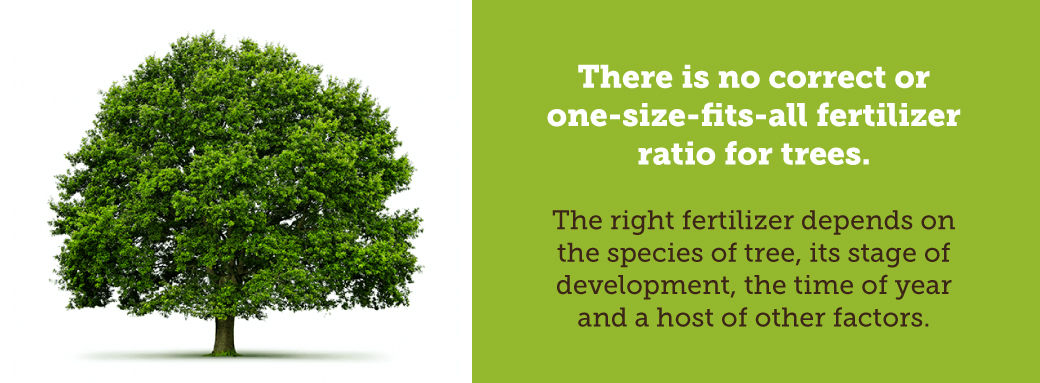
The soil’s potential for alkalinity or acidity, or pH, is another critical contributor to tree health. The average pH on properly functioning soil should be around 5.5. Levels below 5.5 will cause trees to have weak trunks and limbs as well as poor leaf or needle growth. High pH levels can also have devastating effects.
General test kits are readily available for checking soil pH levels. Professional laboratory testing is far more accurate, though, and will identify a host of other soil conditions that can’t be determined by a non-professional.
Soil Structure
Soil’s overall structure is a key factor in how well nutrients, oxygen and water are delivered to the roots. Structure is described as having these key properties:
- Texture that has proportions of stones, silt, sand, clay, gravel and debris. These provide a heavy base for roots to anchor in and don’t negatively impact other soil ingredients unless exceeding approximately 15 percent of the volume.
- Remnant structure that consists of lumps, balls or clumps of mineral material. Remnants are conglomerate pieces that have been broken from undisturbed, natural soil by tilling or excavating. They’re useful for rebuilding soil and providing drainage cavities.
- Density is the level of soil compaction. Poor soil is densely compacted and is a mark of old soil that needs rehabilitation by loosening the density to provide aeration and water flow. Heavy compaction often occurs where tree roots are forcing themselves under pavement or concrete pads.
- Profile is the term for the entire soil makeup — specifically, how it changes in structure in vertical and horizontal distances across the entire soil area that services a tree. Usually, there is more organic material and looser till in the upper profile of soil.
- Color and odor are secondary indicators of healthy or poor soil. Surface soil is usually darker and wetter than base soil. There is usually more odor to darker and healthy soil, except when soil is low on oxygen. Then it will emit a foul, rotten smell.
- Oxygen content is highly important for soil health. Good soil contains approximately 25% air by volume. Air content below 3% is considered “dead air” and is toxic to trees and other plant life.
- Potential for hydrogen, or pH, is an indicator of whether soil is acidic or alkaline. A pH rating of 5.5 is considered neutral and optimum. Lower ratings are more acidic and higher ratings are alkaline. Soil pH can easily be adjusted with additives.
- Drainage is an important property for decent soil. Proper soil structure should be able to retain sufficient water to feed trees, but not be saturated to the point of drowning the roots. Conversely, soil high in loose minerals and low in organics will drain too quickly and cause drought and shock.
- Solid organic matter (SOM) is more frequently referred to as “compost.” It’s the tangible by-product of decomposing organic matter that feeds microbial life and converts it to energy for good tree health.
Understanding these soil properties, how they relate to each other and how they impact trees is the first step in knowing how to rehab damaged and old soil.
Soil Profile Rebuilding
Soil profile rebuilding (SPR) is a rehabilitation technique that restores soil’s biological functions and supports good tree health. This technique improves tree growth, storm water capture, rooting depth and carbon sequestration in old soils or those that have been damaged by land development.
This soil improvement approach identifies whether compaction must be lightened, mineral particles need to be rebalanced or whether additional organic materials are needed. This doesn’t just involve a digging or tilling program — it also takes into account nature’s freeze and thaw cycles and the mobile action of beneficial insects, earthworms and animals.
Projects where SPR programs were introduced showed that trees established more quickly, appeared visually fuller, grew faster and doubled their canopy spread over a seven-year period. SPR researchers are quoted as saying, “When you give trees what they need, it doesn’t take that long for them to grow and fill in beautifully.”
Another research project involving rehabilitated soil conditions for planting trees was extremely encouraging. This involved rejuvenating dirt, rather than enriched soil. They even put together an acronym for the word “dirt.” Recognizing that much of old ground material was anthropogenic or synthetic, they started with soil that was simply “dirt,” or:
- D — Dense
- I — Inert
- R — Reduced
- T — Tainted
The project workers realized that much of the soil in urban areas contains inert, polluted materials like slag, concrete, ash, charcoal, broken glass and building material remnants. Nevertheless, they recognized that damaged urban soils, or dirt, were salvageable and went about designing a better soil for trees placed in urban landscapes.
These rehabilitation results for old and damaged soil are easy to replicate for any conditions. They clearly show how to rehab damaged soil and what the best soil for trees really is. Here, in brief, is their approach and their results for repairing damaged soil.
The American-based project started with 66 Linden trees with a 1.2-inch caliper diameter and a 20-gallon root ball. They planted them in three control groups of soil:
- Native soil with 100% topsoil and no additives
- Tree soil specially blended with 60% topsoil, 15% compost and 25% sand
- Urban soil found at 60% sand, 25% topsoil and 15% compost
Three growth indicators were monitored over the course of one year:
- Soil respiration measuring carbon dioxide and oxygen levels
- Tree leaves testing chlorophyll, moisture, insect activity and stomatal respiration
- Tree dimensions including height, girth and branches
The group found data results that were outside the standard expected error range. They concluded that:
- Trees growing in tree soil exhibited far longer seasonal conductance and had higher leaf production. The soils actually improved in natural organic matter and lowered salts. Native soil was next and urban soil came in a distant third.
- Tree soil had significantly lower bulk density, making rooting easier. Native soil stayed at the same density. Urban soil gained far higher bulk density. This made rooting very difficult.
- Tree soil had the best moisture retention, followed by native soil then urban soil.
- Tree soil retained the best pH level, the best nutrient level and produced far stronger and larger trees.
Without question, soils that have been properly prepared for tree growth proved to have greater returns than native soil and older, more degraded urban soil. This tree soil mixture is simple, economical and efficient. The drawback for existing trees is that it’s not practical or advisable to dig up or disturb soil at the base of mature trees.
There is another way to get fresh fertilizer and nutrients deep under the surface and to the roots of existing trees. This technique has been used for ages and has excellent results in helping to rehabilitate old or damaged soil for optimum tree health. This technique is called “deep root fertilization.”
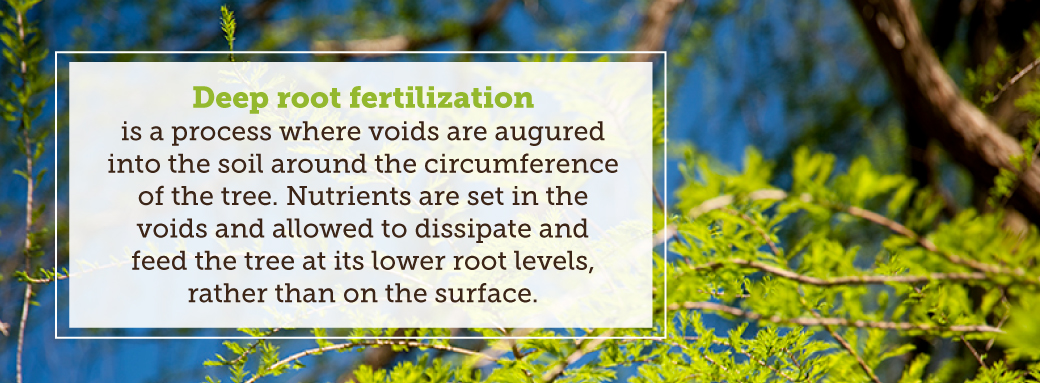
Deep Root Fertilization by Richard’s Tree Service
Deep root fertilization is a process where voids are augured into the soil around the circumference of the tree. Nutrients are set in the voids and allowed to dissipate and feed the tree at its lower root levels, rather than on the surface.
Some arborists employ high-pressure injections of liquid fertilizer using sophisticated and expensive equipment. The theory is that, in order to access the deepest roots, a lot of force is required. This isn’t necessarily so.
There’s a simpler, cheaper and equally effective method of deep root fertilization where holes are drilled about three feet apart and 12 to 16 inches down. These holes are filled with granular fertilizer with a timed release suitable to the soil, season and species of tree.
Richard’s Tree Service provides soil rehabilitation services and deep root fertilization services, along with trimming, pruning and tree removal in Fairfax, VA and across the region. For more information on how deep root fertilization can improve the health of your trees, visit our website for additional resources about this technique, plus other ways to rehabilitate your backyard soil and safeguard the long-term health and beauty of your trees.
If it is an emergency please call us immediately at 703-354-3667.
Use this form to schedule a FREE estimate. After submitting your form, our team will contact you to set up this appointment.
